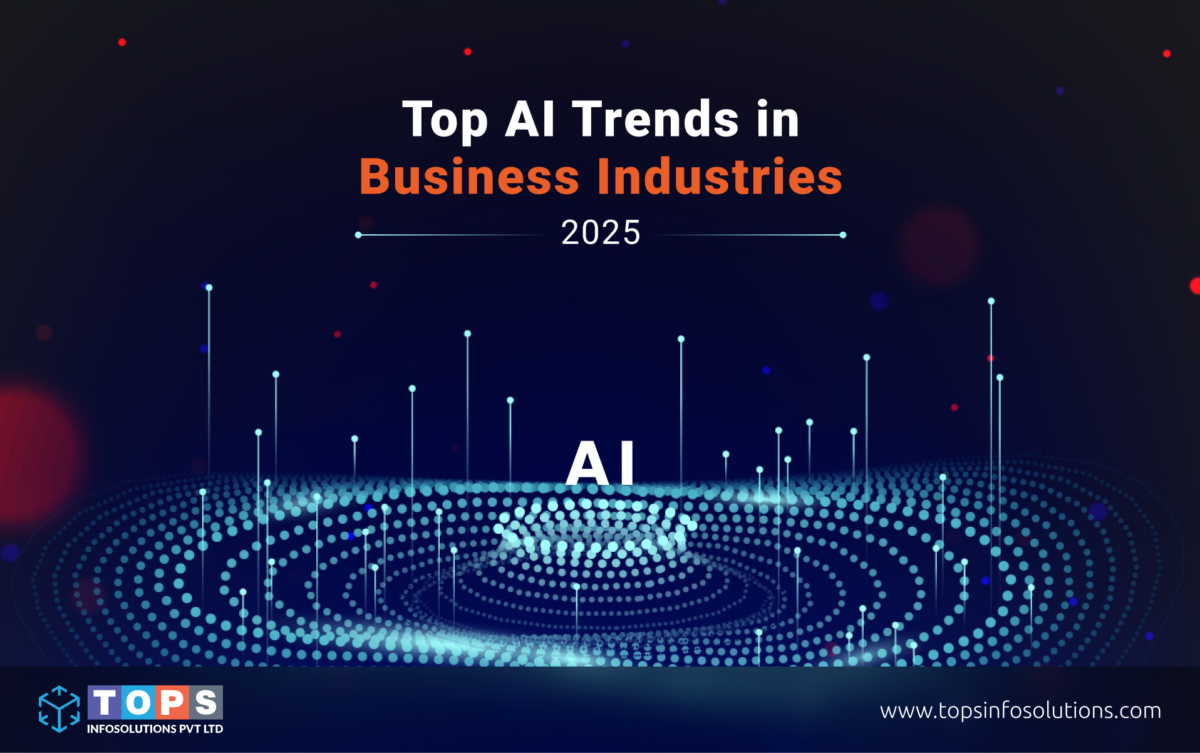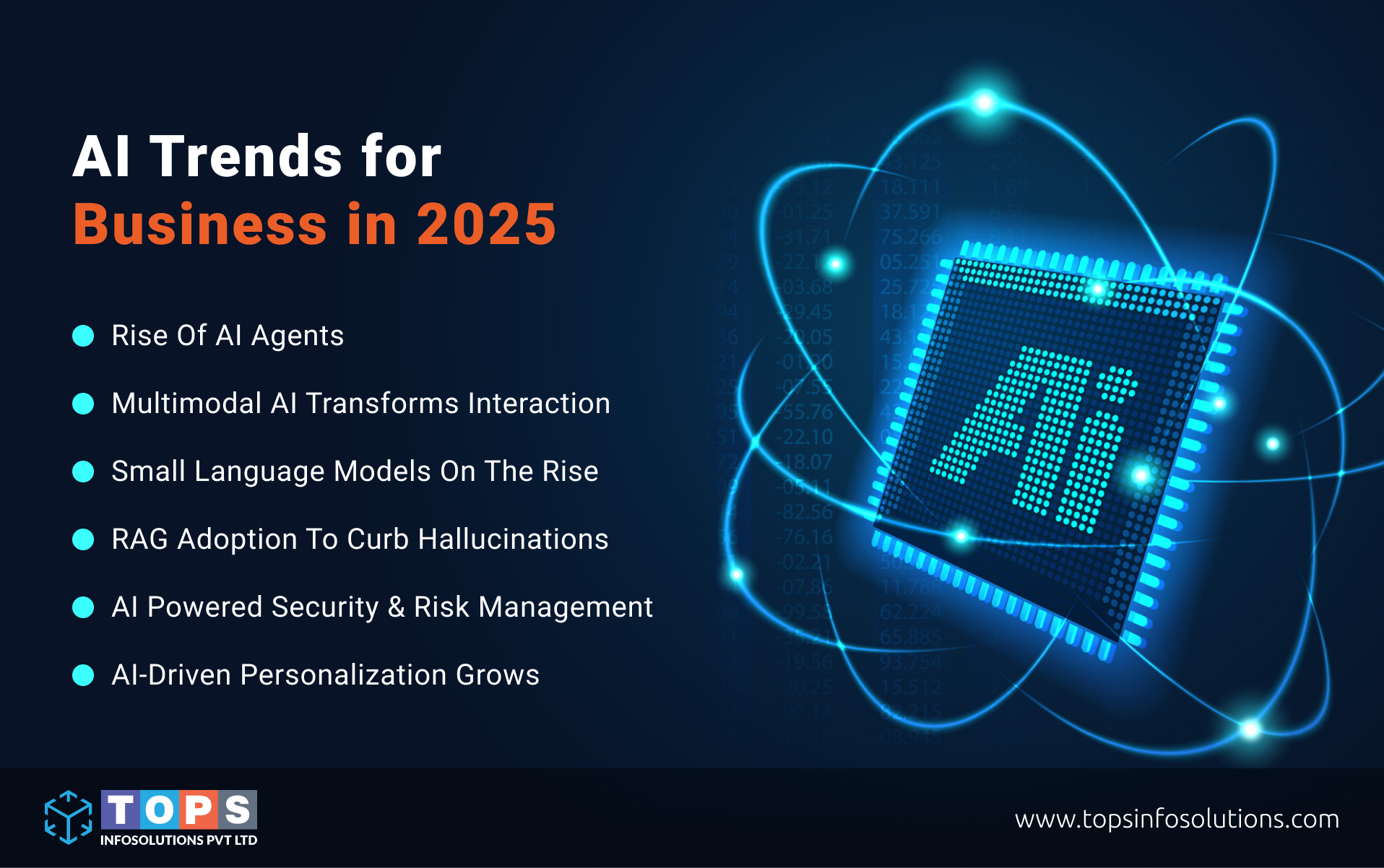Table of Contents
Top AI Trends in 2025: Transforming Businesses Across Industries

Artificial Intelligence didn’t just evolve in the past year; it went mainstream. With its democratization, AI moved beyond tech circles and made its way into everyday business operations.
Want to conduct better research?
Want to transcribe meetings?
Or predict project timelines?
There’s just one answer: “Use AI.”
A Stanford research study shows that 78% of organizations reported using AI in 2024. This figure is up from 55% the year before.
But despite its popularity, businesses are still figuring out the line between hype and real impact. Some AI use-cases fade fast, while others reshape industries.
So, what are the top AI trends in 2025 that businesses think are worth betting on?
Let’s find out.
Emerging AI Trends for Businesses in 2025
The coming year will see a lot more artificial intelligence out of its experimental stage. Below are the top AI trends of 2025 that are setting the stage for real-world transformation across industries.

1. The Dramatic Rise of AI Agents
AI agents are claiming the top spot in emerging AI trends, and rightfully so. With preconfigured rules, they can undertake complex tasks and provide a wide range of solutions that would normally need human intervention. It’s no wonder that AI agents are achieving phenomenal success in streamlining business processes.
And that is just the beginning. In 2025, we’re rapidly moving towards a multi-agent framework where multiple agents interact with each other to complete a task. Think of it like a digital team where each agent has a specialty and works collaboratively and autonomously to achieve a goal.
The multi-agent framework automates entire workflows instead of just isolated tasks. Say you want to create a market research report. You can employ multiple agents, such as:
- Research agent: An agent that collects and gathers external data, like the latest reports and news.
- Analyzer agent: Uses the resources gathered by the research agent to analyze product trends, market size, key trends, and product differences.
- Summarizer agent: Generates a summary and highlights key points to prepare a concise executive summary.
- PM agent: Plays the role of a manager by ensuring timely completion and coordinating workflows.
Tools like AutoGen (by Microsoft), Agentflow, LangChain, and CrewAI are some top tools to develop a multi-agent framework.
The massive use is also credited to its no-code and easy setup. No-code agents fuel the demand for custom AI chatbots for businesses that can autonomously handle complex workflows. With the AI agent market projected to grow at 45% CAGR over the next five years, their momentum is impossible to ignore.
2. Multimodal AI is Reshaping Human–Machine Interaction
Earlier, our interactions with AI occurred through limited means like text or voice. As an additional step, multimodal AI for business can process and respond to multiple types of data, like images, sounds, video, and text, at once. It can perform advanced tasks that single-agent AI cannot.
Imagine this: As a healthcare provider, you want to speed up the patient diagnosis process and improve documentation. With multimodal AI, you can first take a video appointment that tools like GPT can transcribe. It also pulls data from an integrated EMR (Electronic Medical Records) to get a detailed background of the patient.
In the next step, the patient uploads the image of an X-ray or skin condition. The data is passed to LLMs once these images are analyzed by medical vision apps. LLMs combine all the speech, text, image, and EMR to add context.
Using an agent workflow framework like LangChain, you can automate EMR entry, generate personalized instructions, and schedule follow-up appointments. Finally, you can use the data to follow up, and the patient gets a voice or text summary.
Multimodal AI has made this possible, and it’s precisely where we’re headed. We’re able to have more natural and intuitive experiences with technology. This can transform customer experiences and even simplify layered tasks in different industries.
3. Small Language Models are Gaining Big Traction
Large Language Models (LLMs) are great at generating a wide range of information, considering the massive amount of data they process. But they also often require longer processing times and computational power. As an alternative, businesses are welcoming Small Language Models (SLMs) that require less memory, making them ideal for resource-constrained environments.
The best part is that SLMs are equally as capable as their LLM counterparts. In fact, they’re only ‘small’ when compared to LLMs. Most of these models have at least a billion parameters as compared to hundreds of billions or trillions of parameters of LLMs. For example, there’s Qwen2 and Mistral Nemo 12B for complex NLP tasks. Other examples that balance size and performance include Gemma 2 by Google, Phi-3 by Microsoft, and Llama 3 by Meta.
They’re able to process information faster with superior security, and are even making custom AI solutions accessible to smaller businesses. SLMs are also practical for users who don’t require the advanced capabilities of an LLM like GPT-4 / GPT-4o. They help save costs and carry out specialized tasks.
4. Increasing Use of RAG to Reduce AI Hallucinations
Ever asked an AI something, only to get a completely wrong (but confident) answer? That’s called AI hallucinations, and they pose a big challenge in generative AI. Here’s the deal: if the AI doesn’t have enough data, it takes the reins and fills in the blank itself. At its core, AI generates responses based on probability and not based on what’s right.
This is where Retrieval Augmented Generation (RAG) comes in. RAG paves the way for giving context to AI to provide accurate answers and improve the output of generative AI in business. It links generative AI services to external resources, backed by technical information, and tailors the LLM responses by integrating domain-specific data.
Let’s say you want to make your company policies accessible on LLMs so that your employees can have a single source of truth with key information at their fingertips. However, LLMs are not trained to provide answers that cater specifically to your business. To help it do so, you can incorporate your company-specific proprietary data into a pre-trained LLM to provide personalized and contextual responses.
But how does RAG work with LLMs?
Through workflow automation tools like LangChain, LangGraph, Windsor, and N8n. If your documents are converted to structured, searchable files, these tools can index the content and allow an LLM to retrieve the most relevant sections. The tools automatically trigger workflows when a new file or data source is added and can connect multiple tools seamlessly.
5. Putting AI at the Frontline of Security & Risk Management
Yesterday’s security threats were a face-off between humans and machines. Today, they’re between AI and AI. The same technology that creates risk is now key to defending against it. While AI poses a great number of threats, like deepfakes and phishing, it can also protect data by flagging potential threats or disruptions before they escalate.
Without AI-powered security protection, your data could become vulnerable to the very technologies driving progress. Currently, businesses are using AI to monitor regulatory, financial, and operational risks by scanning massive volumes of structured and unstructured data.
To mitigate the risks, AI-powered security is helping businesses protect data, make unbiased decisions, and ensure regulatory compliance. For example, AI-powered threat detection tools like DarkTrace can detect unusual login behavior or data access before we notice it manually. It utilizes self-learning AI to gauge typical behavior for network users or devices. It flags unusual activities and immediately detects suspicious activities like logins or breaches across the network.
Meanwhile, other tools like Security Copilot assist cybersecurity professionals in summarizing incidents, generating reports, or suggesting tips in real-time. AI-powered security plugins are also becoming common for improving security and risk management, where the tools don’t just detect threats but also automate routine tasks like scanning vulnerabilities and responding to common threats.
6. AI-powered Personalization Will Continue
Personalization using AI is not a new concept. But the current AI trends surge towards hyper-personalization, where AI doesn’t just react to customer behavior, it predicts it. It determines what customers want before they know it, based on demographic indicators, behavioral data, and emotional cues.
Hyper-personalization touches multiple touchpoints in a customer journey rather than adding a mere name in emails or making personalized recommendations. AI-powered personalization enables dynamic pricing based on user segment, generates personalized landing pages and content based on intent, and facilitates real-time adjustments to UX based on individual interaction patterns.
For example, AI-powered tools like Persado or Copy.ai use generative AI to create multiple variants of marketing messages. These tailored messages target different audience segments or even individuals. There’s also the introduction of emotional recognition software and facial expression analysis tools like Affectiva and Hume AI that execute mood-based personalization.
Moreover, online retail giants like Amazon are working on advancing personalized recommendations. The recommendations are trained to include emotional sentiment extracted from interactions, along with user intent and browsing behavior. For businesses, this translates to higher engagement and stronger loyalty.
Moving Forward
While there’s growing pressure to implement AI quickly, businesses must first lay the groundwork for its ethical use. The future of AI isn’t just driven by innovation, but also by responsibility.
As the future trends of artificial intelligence unfold, they are increasingly accompanied by rising demands for governance and transparency. Only businesses that balance implementation with structure can lead with impact. If you’re looking to integrate AI-powered solutions, we’re here to help!

